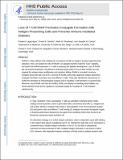| dc.contributor.author | Lagarrigue, Frederic | |
| dc.contributor.author | Ginsberg, Mark H. | |
| dc.contributor.author | Cantor, Joseph M. | |
| dc.contributor.author | Gertler, Frank | |
| dc.date.accessioned | 2018-06-19T17:53:31Z | |
| dc.date.available | 2018-06-19T17:53:31Z | |
| dc.date.issued | 2017-04 | |
| dc.date.submitted | 2016-10 | |
| dc.identifier.issn | 0022-1767 | |
| dc.identifier.issn | 1550-6606 | |
| dc.identifier.uri | http://hdl.handle.net/1721.1/116414 | |
| dc.description.abstract | Rap1-interacting adaptor molecule (RIAM) is a Rap1 effector that mediates the recruitment of talin to integrins, thereby supporting their activation. In this study, we investigated the role of RIAM in an adoptive transfer model for type I diabetes and report that RIAM expression in T cells is necessary for diabetes development. Loss of RIAM did not prevent lymphocyte recruitment to draining lymph nodes 24 h after transfer, but it was required for Ag-driven proliferation and cytotoxic killing. RIAM is recruited to immune synapses along with talin and LFA-1, and loss of RIAM profoundly suppresses Ag-dependent conjugate formation in primary naive and effector T cells. These data identify the requirement of RIAM for formation of immunological synapses and in resulting T cell functions in autoimmunity. Moreover, because RIAM-null mice are healthy, fertile, and display no bleeding abnormalities, our results identify RIAM and its regulators as potential targets for therapies of T cell-mediated autoimmunity. | en_US |
| dc.description.sponsorship | National Institutes of Health (U.S.) (Grant K01DK090416) | en_US |
| dc.description.sponsorship | National Institutes of Health (U.S.) (Grant P30DK063491) | en_US |
| dc.description.sponsorship | National Institutes of Health (U.S.) (Grant P01HL-078784) | en_US |
| dc.description.sponsorship | National Institutes of Health (U.S.) (Grant R01HL-117807) | en_US |
| dc.publisher | American Association of Immunologists | en_US |
| dc.relation.isversionof | http://dx.doi.org/10.4049/JIMMUNOL.1601743 | en_US |
| dc.rights | Creative Commons Attribution-Noncommercial-Share Alike | en_US |
| dc.rights.uri | http://creativecommons.org/licenses/by-nc-sa/4.0/ | en_US |
| dc.source | PMC | en_US |
| dc.title | Cutting Edge: Loss of T Cell RIAM Precludes Conjugate Formation with APC and Prevents Immune-Mediated Diabetes | en_US |
| dc.type | Article | en_US |
| dc.identifier.citation | Lagarrigue, Frederic et al.“Cutting Edge: Loss of T Cell RIAM Precludes Conjugate Formation with APC and Prevents Immune-Mediated Diabetes.” The Journal of Immunology 198, 9 (March 2017): 3410–3415 © 2017 American Association of Immunologists, Inc | en_US |
| dc.contributor.department | Koch Institute for Integrative Cancer Research at MIT | en_US |
| dc.contributor.mitauthor | Gertler, Frank | |
| dc.relation.journal | Journal of Immunology | en_US |
| dc.eprint.version | Author's final manuscript | en_US |
| dc.type.uri | http://purl.org/eprint/type/JournalArticle | en_US |
| eprint.status | http://purl.org/eprint/status/PeerReviewed | en_US |
| dc.date.updated | 2018-06-18T14:29:54Z | |
| dspace.orderedauthors | Lagarrigue, Frederic; Gertler, Frank B.; Ginsberg, Mark H.; Cantor, Joseph M. | en_US |
| dspace.embargo.terms | N | en_US |
| dc.identifier.orcid | https://orcid.org/0000-0003-3214-4554 | |
| mit.license | OPEN_ACCESS_POLICY | en_US |
